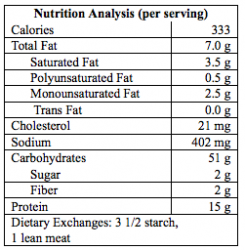What is it we love about pizza? From a food group standpoint, it’s a well balanced choice that can include grains (crust), protein, vegetables, dairy, and even fruit! Just like all food choices, some options within each group are better than others. Here are some quick tips to making over a pizza – and why the swaps could help prevent heart disease.
Crust – Using a liquid oil makes cooking heart smart instantly. Limiting saturated and trans fats in addition to monitoring dietary cholesterol is a great way to help with blood cholesterol levels – both by helping the HDL (good) cholesterol and lowering the LDL (bad) cholesterol. Take it a step farther in cooking by trying out some whole grain options in all your grain choices from bread to crackers to pasta.
 Toppings – Skip the extra sodium by using a low sodium or no salt added tomato base. Using fresh sliced tomatoes is a great option for minimizing added sodium in addition to adding fiber instead of using a sauce. Choosing cheese made with part skim milk or other light cheese zaps saturated and total fat, as does using a leaner protein like Canadian bacon in place of high fat pepperoni. Adding extra veggies like onion, bell pepper, mushrooms, or other favorites simply adds nutrients plus loads of taste. Customize your heart smarter pizza today! Here’s a recipe from the American Heart Association for starters. For more information on a healthy heart, visit www.goredforwomen.org or www.americanheart.org.
Toppings – Skip the extra sodium by using a low sodium or no salt added tomato base. Using fresh sliced tomatoes is a great option for minimizing added sodium in addition to adding fiber instead of using a sauce. Choosing cheese made with part skim milk or other light cheese zaps saturated and total fat, as does using a leaner protein like Canadian bacon in place of high fat pepperoni. Adding extra veggies like onion, bell pepper, mushrooms, or other favorites simply adds nutrients plus loads of taste. Customize your heart smarter pizza today! Here’s a recipe from the American Heart Association for starters. For more information on a healthy heart, visit www.goredforwomen.org or www.americanheart.org.
Fresh Veggie and Canadian Bacon Pizza with Homemade Crust
Recipe courtesy of Alton Brown
Serves 8: 2 slices per serving
Crust
4 cups all-purpose flour, plus ½ cup set aside
1 envelope instant yeast
1 teaspoon sugar
1/2 teaspoon salt
1 1/4 cups tepid water
1 tablespoon olive oil
Cornmeal for dusting the peel
Toppings
2 cups part-skim mozzarella or other reduced-fat cheese
2 medium tomatoes, sliced
2 ounces Canadian bacon, diced
2 cups sliced or chopped fresh vegetables, such as mushrooms, zucchini, broccoli, asparagus, or onions, or a combination
4 teaspoons thinly sliced or finely chopped fresh herbs, such as basil or oregano, or a combination
 Directions:
Directions:
If using a standing mixer, in the bowl whisk together the 4 cups of flour, yeast, sugar, and salt. Pour in the water. Attach the dough hook. With the mixer on low, beat until the dough forms a ball, stopping the mixer and pushing down the dough with your hands as needed so it combines well. If the dough is sticky, add some of the remaining 1/2 cup flour, 1 tablespoon at a time, and beat for 2 to 3 minutes, or until the dough pulls away from the side of the bowl.
If mixing by hand, in a large bowl stir together the 4 cups of flour, yeast, sugar, and salt using a large wooden spoon. With your hands, blend the dough into a ball. If the dough is sticky, add some of the remaining 1/2 cup flour, 1 tablespoon at a time, working it in for 3 to 4 minutes, or until the dough is smooth and does not stick to the side of the bowl.
For either method, set the dough aside to rest for 15 minutes.
To knead the dough with the mixer, beat on medium-low until smooth and elastic, about 5 minutes. Turn the dough out onto a lightly floured surface. Push the dough away from you with the heels of your hands. Fold the dough back over onto itself. Continue to knead the dough for about for about 30 seconds, or until the dough is smooth and elastic, then work the dough into a ball.
To knead by hand, turn the dough out as directed above and knead for 8 minutes, or until the dough is smooth and elastic. Work the dough into a ball.
Lightly coat a large, clean bowl with 1 teaspoon of the olive oil. Put the dough in the bowl, cover with a clean kitchen towel, and set aside in a warm place (about 85ºF) until the dough doubles in size, about 1 hour.
Fold down the dough, patting it into a disk, and place it back in the bowl. Cover with plastic wrap and refrigerate overnight. The next day, remove the dough and cut into two equal portions. Shape each into a ball.
If you plan to use the dough that day, leave it on the counter, covered with a clean kitchen towel, for 1 hour to let it relax so shaping is easier. If you plan to use the dough another day, wrap it well in plastic wrap or put in an airtight plastic bag, and refrigerate for up to 1 week. For longer storage, freeze the dough, then when you’re ready to use it, thaw it overnight in the refrigerator.
To prepare the dough, put it on a large, lightly floured surface, such as a counter, and press each piece of the dough into a flat disk. Work one disk in your hands, rotating it around and around while pulling it out gently until it is 12 inches in diameter. Repeat with the second disk.
If available, set one or two pizza stones on the oven rack in the lower third of the oven. Preheat the oven to 500ºF.
Dust the peel with cornmeal and place the dough on top. Brush each pizza with 1 teaspoon olive oil. Sprinkle with the cheese. Top, in order, with the tomato slices, Canadian bacon, vegetables, and herbs. Slide the pizza off the peel and onto the pizza stone in the oven.
If you do not have a pizza stone, turn two sheet pans (at least 12×18 inches) over and sprinkle lightly with cornmeal. Assemble as directed above. (If you have only one sheet pan, assemble only one pizza at this point.)
Bake the pizzas for 8 minutes, or until the cheese is bubbly and the crusts are golden brown. Let the pizzas rest for 3 minutes before cutting each into 8 slices. Serve 2 slices to each person.
This recipe is brought to you by the American Heart Association’s Face The Fats program. Recipe copyright © 2007 by the American Heart Association. Look for other delicious recipes in American Heart Association cookbooks, available from booksellers everywhere.
Watch for up to date information every week. If there is a specific health or nutrition related issue you would like more information on, please e-mail us at nutricion@lawndalenews.com or write to:
Lawndale News
5533 W. 25th St.
Cicero , IL 60804
ATTN. Fresh Take on Health and Nutrition Column from Jewel-Osco
Until next time!











